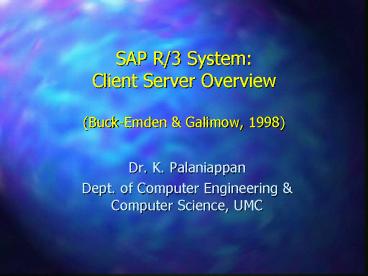SAP R3 System: Client Server Overview BuckEmden PowerPoint PPT Presentation
1 / 30
Title: SAP R3 System: Client Server Overview BuckEmden
1
SAP R/3 System Client Server Overview(Buck-Emd
en Galimow, 1998)
- Dr. K. Palaniappan
- Dept. of Computer Engineering Computer Science,
UMC
2
Business Data Processing
- Radical changes
- Information Management
- The deciding competitive factor
- Short innovation cycles, global competition, high
costs - Enterprise-wide information/resource management
3
Business Data Processing
- Corporate Competitiveness
- Business re-engineering optimization of all
business processes along with the entire
net-value added chain - Technology re-engineering use latest data
processing (DP) technology for optimization of
ERM, ERP - Past Function Orientation
- Business data processing administrative support
for functions like accounting, materials
management, etc.
4
Business Data Processing
- vs Present Customer Orientation
- Optimization of entire business process
- DP support for business process reduce
inventory, improve delivery, flexibility, improve
quality, minimize cost, etc.
5
Requirements for EIM
- Functional
- Online integration of all business applications
and data in the company vs (obsolete centralized
with alphanumeric screen-based) batch processing - Timely provision of operational business
information - Universal support of customer/firm/vendor
business processes - Customization and adaptation to changing business
conditions - Data and program integration with desktop tools
- Intuitive, consistent user interfaces
6
Requirements for EIM
- Technical and Administrative
- Cost of DP infrastructure
- Portability of business application software
- Lifespan of ten or more years vs hardware,
software, communication technology changes - Scalability to varying load profiles
- Short predictable online response time
- High throughput of background jobs
- 24-hour availability
- Easy systems administration
- Short downtime during release changes
7
Requirements for EIM
- Re-orientation of in-house software development
- Too expensive
- Continual business requirement changes
- Rapid infrastructure changes
- Unpredictable software innovations
8
Component Software as a New Solution
- Not possible to produce integrated software with
all of the functions and modules described by the
customer - Software component reuse
- Integration of application modules
- Microsoft OLE (object Linking and Embedding)
- OMG CORBA (Object Management Group Common Object
Request Broker Architecture) - Interoperability between different vendor
software - Object oriented (Smalltalk, C, Java,) vs
Procedural languages (COBOL, C, ABAP/4,)
9
New Technologies for Business DP
- Client-server computing, GUI, multimedia,
broadband networks - Wireless networks, thin clients, speech
processing, Internet/Web, XML - Middleware
- Software that sits between business applications
and hardware operating system - Critical for client-server applications
development (key enabling technology)
10
Essential Tools of Middleware
- Isolate applications from specific hardware and
system software interfaces (i.e. printing, window
management, network, POS, ATM, DBMS, etc.) - Provide open communication interfaces for
distributed application - Control and monitor distributed transactions
- Access different distributed data sources
- Provide object management functions
11
Classes of Middleware (Gartner Group)
- Middleware for data management
- Remote file systems (i.e. UNIX NFS)
- Database tools and interfaces
- Middleware for support of distributed functions
- Communications (sockets, etc.)
- Remote procedure calls
- Database expansions (replication, mirroring,
etc.) - Transaction monitors
- 4 GL runtime environments
- Object management
12
Client-Server Computing
- Hardware view vs software view
- Computer networks programs that operate on
different computers and asynchronous calls - Calling program client or master
- Called program server or slave
13
Client-Server Configurations
- Centralized system
- Distributed presentation
- Database access across computer boundaries
- Three layer client/server system with distributed
presentation, distributed application logic, and
database access across computer boundaries - Multilayer client/server systems with cooperative
processing
14
Technical Foundation for Client/Server Systems
- Hardware systems CPUs and memory
- High performance local and wide area networks
- System software
15
(No Transcript)
16
(No Transcript)
17
(No Transcript)
18
(No Transcript)
19
(No Transcript)
20
(No Transcript)
21
(No Transcript)
22
(No Transcript)
23
(No Transcript)
24
(No Transcript)
25
(No Transcript)
26
(No Transcript)
27
(No Transcript)
28
(No Transcript)
29
(No Transcript)
30
(No Transcript)

